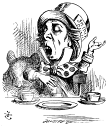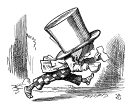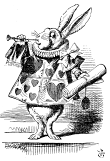Search us!
Search The Word Detective and our family of websites:
This is the easiest way to find a column on a particular word or phrase.
To search for a specific phrase, put it between quotation marks. (note: JavaScript must be turned on in your browser to view results.)
Ask a Question! Puzzled by Posh?
Confounded by Cattycorner?
Baffled by Balderdash?
Flummoxed by Flabbergast?
Perplexed by Pandemonium?
Nonplussed by... Nonplussed?
Annoyed by Alliteration?

Don't be shy!
Send in your question!
Columns from 1995 to 2006 are slowly being added to the above archives. For the moment, they can best be found by using the Search box at the top of this column.
 If you would like to be notified when each monthly update is posted here, sign up for our free email notification list.
If you would like to be notified when each monthly update is posted here, sign up for our free email notification list.
Trivia
All contents herein (except the illustrations, which are in the public domain) are Copyright © 1995-2020 Evan Morris & Kathy Wollard. Reproduction without written permission is prohibited, with the exception that teachers in public schools may duplicate and distribute the material here for classroom use.
Any typos found are yours to keep.
And remember, kids,
Semper Ubi Sub Ubi
|
Up in the air, Junior Birdmen.
Dear Word Detective: Where did the word “cockpit” come from? Was there a petcock or cocktail or peacock involved in the naming for the pilot’s area of an airplane? Secondly, how about “pilot”? — David Blanton.
Petcocks and cocktails and peacocks in the cockpit, oh my! Makes me wish I’d learned to fly. Then again, given my eyesight, we’re all glad I didn’t. In fact, I realized the other day that I haven’t been on an airplane in more than fifteen years. I’ll bet it’s much more fun than it used to be, right?
“Cockpit” in the sense of “area of an aircraft where the pilot, co-pilot, navigator, et al., sit” is just about as old as powered flight itself, first appearing in print around 1914. But the word “cockpit” itself is much older, dating back the the late 16th century, and the “sport” which is the source of “cockpit” is probably much, much older. A “cockpit” in the original literal sense is a pit dug in the ground where cockfights are held, “cockfights” being staged battles between roosters, often outfitted with metal spurs, on which bets are placed. Although cockfighting is illegal in most countries today, it is still depressingly popular around the world.
By the early 1700s, “cockpit” was being used in a figurative sense for any arena of battle or conflict, especially if enclosed, or an area of intense and important activity. It was this “place where the important things are done” sense (and not, thank heavens, the “fighting chickens” meaning) that led “cockpit” to be applied to the pilot’s compartment in an aircraft and, by extension, the “control position” in a racing car, sailboat or similar conveyance.
“Pilot” is also a very old word, and originally meant “one who steers a ship,” a sense expanded in the 20th century to include someone who flies an airplane. English adopted “pilot” from French, but ultimately the word derives from the Greek “pedon,” meaning “steering oar” or “blade of a oar.” Interestingly, the root of that “pedon” is the Indo-European root “ped,” meaning “foot,” also the source of our English “pedal” and “pedestrian,” among other words.
Since you mentioned those other words, we may as well illuminate them a bit. A “petcock” is not a tame chicken (chickens being among nature’s most savage beasts, of course), but rather a small faucet or spigot, usually found on a boiler or similar apparatus, where it is used to drain or relieve pressure. The “pet” part probably comes from an old sense of “pet” meaning “small” (still found in “petty”), and the “cock” part most likely draws a comparison of the faucet handle to the comb of a rooster.
“Peacocks” are not especially fond of peas. Their name is simply a modified form of the Latin name for the bird, “pavo” plus “cock” in the general sense of “male bird.”
As for “cocktail,” fuhgeddaboudit. Etymologists have been arguing about this word since it first appeared in print in 1806. Search the internet for five minutes and you’ll find a dozen theories about the origins of “cocktail,” most of them absurd, some of them vaguely plausible, but not one of them possessing enough evidence on its side to settle the argument. “Cocktail” is the Loch Ness Monster of lexicography, and I, for one, am happy to let this Nessie sleep with the fishes.
Webster or Heimlich?
Dear Word Detective: A friend of mine used the word “larrixter” (which, for all I know, might be spelled “larrickster”) to describe a roguish type — a rascal, a wiseguy, a ladies’ man. Any clue on the origin of that? I’ve tried looking it up but couldn’t find a definitive answer. — Slidedaddy.
Hmm. I have to say at the outset here that hunting down an odd word when we don’t know how it’s spelled is often impossible. In fact, I usually avoid questions along the lines of “My mother just muttered something in the next room that sounded like ‘felfbork.’ What do you suppose she meant?” I’ve learned that in such cases I almost invariably search for hours, only to eventually conclude that the speaker was either insane or talking with her mouth full.
But your question struck me as relatively sober and specific and, while I don’t have a definite answer for you, I do have a plausible theory.
It is true that you can paw through dictionaries and slog through the web until the cows come home and find no trace of anything that resembles “larrixter” or “larrickster” in the sense you mean. If we cast a somewhat looser net, however, we come up with the noun “larrikin,” which is defined by the Oxford English Dictionary as meaning “street rowdy” or “hoodlum.” “Larrikin” is not very common in the US, but it’s a staple of slang in Australia and New Zealand, where it has a long history dating back to the 1860s. “Larrikin” was first used as a strong pejorative in reference to criminal gangs in the late 19th century (“We are beset with larrikins, who lurk about in the darkness and deliver every sort of attack on the walls and roof with stones and sticks,” 1868), but has since been tempered into a rough synonym of “rascal” or “rogue” with overtones of “free-spirited rebel.”
The origin of “larrikin” is, alas, unknown, but its roots apparently lie in the dialectical slang of 17th and 18th century England, and it may be related to the verb “to lark,” meaning “to play tricks or frolic.” There is, for example, an English dialect verb “larack,” meaning “to lark about.”
The similarities in both form and meaning of “larrikin” to the “larrickster” we seek are obviously very strong, and I, for one, am convinced that they are actually the same word. As for how “larrikin” might have morphed into “larrickster,” I think we may be seeing the result of an unconscious effort to make “larrikin” conform to the more familiar form of English “agent nouns.” An agent noun is a person or thing that performs the action of a given verb, as a “driver” drives, an “editor” edits, etc. Agent nouns in English almost always end in “er” or “or,” and sometimes in the form “ster” (e.g., trickster, fraudster). It is entirely possible that the unusual ending “in” in “larrikin” led someone to assume that a verb “to larrik” underlies the word (as it may). So, over time, the weird “in” ending was trimmed from “larrikin” and “ster” was added to make it sound more like a person who “larriks.” Voila, “larrickster,” or something like it.
This just in.
Dear Word Detective: I’ve always thought the term was “brand new,” but was re-reading E.M. Delafield’s “Diary of a Provincial Lady” recently, and noticed that she twice wrote “bran-new.” What is the origin of this term? Have I been mishearing it as “brand new,” or has it evolved? — Megan Coughlin.
This is an interesting question. I actually answered a similar query about twelve years ago, but in that case a reader had seen “bran-new” in a newspaper, where it could easily have been a typographical error. This time we’re talking about a very well-known semi-autobiographical novel that has been in print since 1930 and is widely considered a classic work of humor in Britain.
Incidentally, I was vaguely aware of E.M. Delafield (pen name of, fasten your seatbelts, Edmée Elizabeth Monica Dashwood), but have never read “Diary of a Provincial Lady.” According to Wikipedia, it’s a novel in the “form of a journal of the life of an upper-middle class Englishwoman living mostly in a Devon [England] village of the 1930s.” I found a brief excerpt online, and it seems to be the sort of thing I like, so I’ll add it to my to-read list (which, unfortunately, stretches through 2075 at this point). By the way, if I were going to recommend one book to anyone contemplating moving to rural Ohio, it would be “Cold Comfort Farm” by Stella Gibbons. It’s where I learned to wash dishes with a twig.
“Brand new,” of course, means “completely new, unused,” and has been in constant use since at least the late 16th century. The “brand” in “brand-new” (the hyphenated original form) is “brand” in its Old English sense of “burning piece of wood” or, more generally, “fire.” Something that is “brand new” is as new as if it had just emerged from the fire of a forge (e.g., a sword) or kiln (pottery, etc.). Shakespeare expressed the same concept in his use of the similar phrase “fire-new.” The use of “brand” to mean “proprietary name for one’s product” in the “Coke” sense is a later use of “brand,” most likely taken from the vintners’ practice of marking wooden wine casks with an iron “brand” heated in a fire.
The spelling “bran-new” might seem like a recent mutation, but it’s actually been fairly common since about 1714, cropping up in both Dickens and Twain. This spelling seems to be a case of “folk etymology,” in which an unfamiliar element (“brand”) is replaced by a more familiar one (‘bran”). A similar process transformed “buttonhold” (originally a loop of string) into “buttonhole.” The fact that the “d” in “brand new” is usually not pronounced probably added to the evolution of “bran-new.”
Ironically, the fact that “brand” has become a far more common word in the past hundred years has short-circuited this process of modification, and made “bran-new” less acceptable than it once was. E.M. Delafield got away with it in 1930, but it would be hard to find an editor or teacher today who did not consider “bran-new” an error.
|
Makes a great gift! Click cover for more.  
400+ pages of science questions answered and explained for kids -- and adults!
FROM ALTOIDS TO ZIMA, by Evan Morris
 
|


 can be found
can be found 




Recent Comments